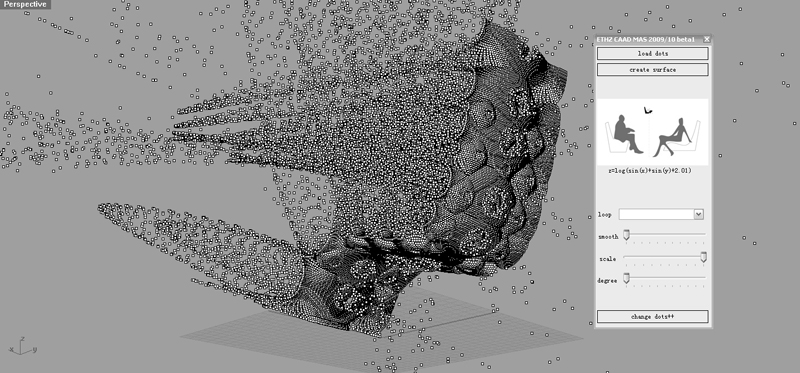iteration & recursion
the main Sub of vb.net SDK
Private Sub Iteration_Click(ByVal sender As System.Object, ByVal e As System.EventArgs) Handles Iteration.Click
Dim context As MRhinoDoc = RhUtil.RhinoApp.ActiveDoc()
Dim SPoints As New List(Of On3dPoint)
Dim SVectors As New List(Of On3dVector)
For i As Integer = 0 To SPoints.Count() - 1
Dim j As Double
Dim k As Double
Dim l As Double
j = i \ chair_width
k = i Mod chair_width
l = Math.Log(Math.Sin(j / scale_m) + Math.Sin(k / scale_m) + smooth + 2.01)
SVectors(i) = SVectors(i) * l
SPoints(i) = SPoints(i) + SVectors(i)
context.AddPointObject(SPoints(i))
Next
context.Redraw()
End Sub

Recursive algorithms
From Wikipedia
A common method of simplification is to divide a problem into sub-problems of the same type. This is known as dialecting. As a computer programming technique, this is called divide and conquer, and it is key to the design of many important algorithms, as well as a fundamental part of dynamic programming.
Virtually all programming languages in use today allow the direct specification of recursive functions and procedures. When such a function is called, the computer (for most languages on most stack-based architectures) or the language implementation keeps track of the various instances of the function (on many architectures, by using a call stack, although other methods may be used). Conversely, every recursive function can be transformed into an iterative function by using a stack.
Most (but not all) functions and procedures that can be evaluated by a computer can be expressed in terms of a recursive function (without having to use pure iteration),[citation needed] in continuation-passing style; conversely any recursive function can be expressed in terms of (pure) iteration, since recursion in itself is iterative too.[citation needed] In order to evaluate a function by means of recursion, it has to be defined as a function of itself, along with a base case to finish recursion. For example, the factorial function can be defined recursively as n! = n * (n - 1)! , where 0! is defined as 1, the base case. Clearly thus, not all function evaluations lend themselves to a recursive approach. In general, all non-infinite functions can be described recursively directly; infinite functions (e.g. the series for e = 1+1/1!+1/2!+1/3!...) need an extra 'stopping criterion', e.g. the number of iterations, or the number of significant digits, because otherwise recursive iteration would result in an endless loop.
G CITY
generation urban structures
Keywords: Generative; Parametric; Tool Development; Simulation; Prediction; Evaluation; City Modeling; Information/Knowledge City
Abstract: As a Generic City study , this case mainly based on existing information systems, and urban development law. Using mathematical model to simulate and generate Generic City. At the same time, this mathematical model can be optimized with evaluation or strategic urban plan.
World Wind is an open source (released under the NOSA license) virtual globe developed by NASA and the open source community for use on personal computers. Old versions need Microsoft Windows but the more recent Java version, World Wind Java, is cross platform and provides a suite of demo apps. The World Wind Java version was awarded NASA Software of the Year in November of 2009 for 2010. The program overlays NASA and USGS satellite imagery, aerial photography, topographic maps and publicly available GIS data on 3D models of the Earth and other planets.
physical computting
a example of mobile processing
Bluetooth is an open wireless technology standard for exchanging data over short distances (using short length radio waves) from fixed and mobile devices, creating personal area networks (PANs) with high levels of security. Created by telecoms vendor Ericsson in 1994,[1] it was originally conceived as a wireless alternative to RS-232 data cables. It can connect several devices, overcoming problems of synchronization. Today Bluetooth is managed by the Bluetooth Special Interest Group. -----From Wikipedia


fidu
try to programming for kuka robot
&ACCESS RVP &REL 14 &PARAM TEMPLATE = C:\KRC\Roboter\Template\vorgabe &PARAM EDITMASK = * DEFDAT BONE_CIRCLE ;FOLD EXTERNAL DECLARATIONS;%{PE}CEXT,P ;FOLD ARCTECHDIGITAL EXT EXT A20 (INT :IN,WELD_ST :IN,WELD_FI :IN,INT :IN ) ;ENDFOLD (ARCTECHDIGITAL EXT) ;FOLD BASISTECH EXT;%{PE}CEXT,P EXT BAS (BAS_COMMAND :IN,REAL :IN ) DECL INT SUCCESS ;ENDFOLD (BASISTECH EXT) ;FOLD TOUCHSENS EXT EXT H70 (INT :IN,SRCH_TYP_2 :OUT,E6POS :IN,SRCH_TYP_3 :IN,SRCH_TYP_2 :IN,SRCH_TYP_2 :IN,SRCH_TYP_2 :IN,SRCH_TYP_2 :IN,SRCH_TYP_2 :IN,INT :IN ) ;ENDFOLD (TOUCHSENS EXT) ;FOLD USER EXT;%{E}CEXT,P ;Make here your modifications
ENDDAT

ecaade
Macro Thinking & Micro Action: A digital simulation example for the southern part of Beijing, China

Abstract. This paper aims to discuss alternative and innovative plan models for Chinese cities that are currently under rapid development. Our study considers Complexity Theories of Cities as theoretical base and applies a holistic approach in city planning by recognizing the complex nature of city. We strive to integrate the diverse local structure in social and spatial aspects with the ambition and demands of city’s expansion. Digital sequence simulation is used as an innovative tool to represent local activities, promote interventions and predict possible self-organization process in the future. The study arrives at an open scenario the feasible prospect. A conclusion is drawn to reflect the process, achievement and weakness of the research. . Keywords. local diversity; living pattern; industrial parameterization; infrastructural parameterization; sequence simulation.